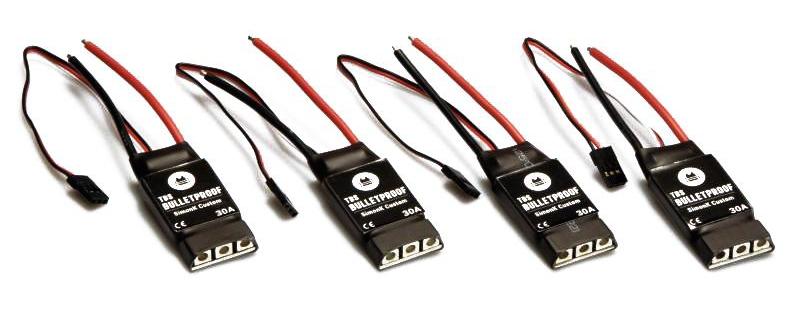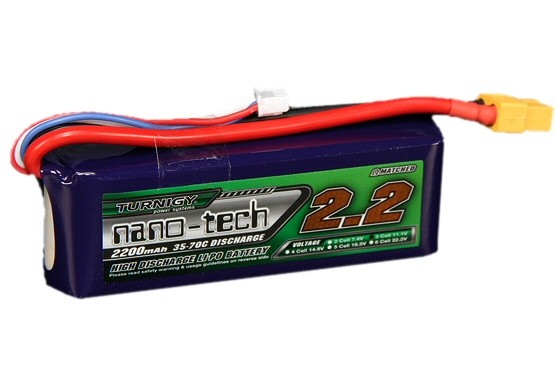Multi-Rotors, First-Person View, And The Hardware You Need
Speed Controllers And Batteries
Electronic speed controllers (ESCs) are used in many R/C applications. They translate signal to electrical supply. On a multi-rotor, every motor gets its own ESC, each of which connects to the flight controller. After computing the inputs, the controller directs each ESC to adjust its speed in order for the craft to perform them.
ESC refresh rates vary. For multi-rotors, given the balance of multiple motors critical to the craft's ability to stay airborne, high refresh rates are more important than many other hobbies where ESCs are used.
In essence, we're talking about programmable microcontrollers, and they employ firmware to define and carry out their tasks. In the world of multi-rotors, SimonK is the supreme ruler of ESC firmware, creating revisions optimized for multi-rotor use, stripped of irrelevant features, and sporting refresh rates as high as 400 Hz or so. ESCs can be flashed or purchased with SimonK's optimizations pre-loaded.
The only other major factor to consider is an ESC's maximum current rating, which must exceed the current draw to each motor. Generally, 30 A for medium/large quads and 10 to 12 A for a small quad is plenty.
Clearly, those are high current draws. But such is the nature of multi-rotors. A medium-sized hex can easily pull 40 A on a steep ascent. As a result, hefty batteries are a necessity for decent flight times.
The industry standard is lithium-ion polymer (LiPo) batteries. Relatively lightweight, compact, and offering high discharge rates, LiPos are well-suited for multi-rotors.
Ready for another set of specifications? There are three to consider as you start perusing the cyber-aisles of LiPo batteries. The first is voltage. A single cell supplies a nominal voltage of 3.7 V (4.2 V at full charge). Each additional cell wired in series adds 3.7 V to the nominal voltage of that pack. Cell counts are denoted by the number of cells followed by "S". A 4S LiPo, therefore, is a battery of four 3.7 V cells at a summation of 14.8 V.
Get Tom's Hardware's best news and in-depth reviews, straight to your inbox.
LiPo packs also have C ratings that indicate the maximum rate at which a pack can be discharged, with C standing for capacity. A 20C pack can be discharged at a rate 20 times its capacity.
Capacity, therefore, is the third important factor. It's measured in milliamp-hours (mAh). Let's say our 20C pack has a capacity of 4000 mAh. Given what we know about C ratings, we can do the math and determine its maximum discharge at up to 80,000 mA, or 80 A. Similar to ESCs, you need a discharge rate that's higher than the combined draw current of your motors.
LiPos connected in parallel add to capacity (rather than affecting voltage). In turn, the aforementioned S notation is modified. A 3S2P arrangement, for example, consists of two three-cell LiPos connected in parallel.
Batteries do not last forever. They vary in cost, and the pricier LiPos typically last for more cycles than the cheaper ones. A pack will “puff” in its plastic wrap as it gets to the end of its rope. Excessive heat after use is another bad sign.
The best way to prolong a LiPo’s life is to follow the 80% rule. You should try to avoid discharging more than 80% of the battery's listed capacity (a maximum of 4000 mAh from a 5000 mAh pack, for example). Also, monitor voltage when you're flying, and land before reaching 3.3 V per cell. Voltage falls more rapidly as charge is depleted, and at 3 V per cell, you might drop out of the sky. Some flight controllers have protection mechanisms to help prevent over-discharge.
Current page: Speed Controllers And Batteries
Prev Page Motors And Propellers: Heavy Lifting Next Page Video Systems: Cameras And Radio Gear-
gio2vanni86 Great article, and quite an amazing beautiful video shot at the end. Been seeing these around, and have really loved the idea of filming at a elevated level. I actually do hope you guys do more of these. I am bookmarking this for future reference. Thank you.Reply -
freiss Darn it, now you've piqued my interest. :-)Reply
As stated below, a rundown on build costs would be nice. Hey, you could even do a series of FPV articles akin to the PC builds...budget, mid-range, and enthusiast! -
Steveymoo So, how much would the components cost to lift a heavy DSLR with some decent glass? I is pretty curious.Reply -
es0 It would be awesome if you did build guides for different aircraft. I have begun building different ground based vehicles using arduinos and Pi's and would love to take to the skys next!Reply -
thechief73 Excellent article, nicely explained. Also glad to see someone in the media make a clarification from drones and multi-copters.Reply
FYI, DO NOT CALL THESE DRONES: Drones are for military use to kill people. These are, as the authors title states: multi-copters, multi-rotors, or RC model aircraft. By using the word "Drone" you give all the uneducated fear mongers and the law writers canon fodder to regulate this hobby into oblivion before it really gets a chance to take off. Some states and other countries have already passed laws that almost or outright make this hobby a CRIME!
I have been in the hobby about a year now and I have to say it is so far one of the most fun and rewarding things I have done. I will be doing this until I no longer have the means to do so. I highly recommend anyone that is interested in joining the hobby to buy a Hubsan X4 or one of the many similar RTF mini-quad models. This is widley regarded as the best way to learn how to fly a multi-rotor.
http://www.youtube.com/user/juz70/videos - not my channel, just really neat.
So, how much would the components cost to lift a heavy DSLR with some decent glass? I is pretty curious.
Just a few options: DJI S1000, SkyJib-8 Ti-QR, and CINESTAR-8.
It would be awesome if you did build guides for different aircraft. I have begun building different ground based vehicles using arduinos and Pi's and would love to take to the skys next!
Check out youtube, there are thousands of guide videos on the subject.
-
HKILLER i would highly recommend these 2 for those who that don't want to go through the trouble of the build and already have an smart device such as iphone or android ones...Reply
http://www.newegg.com/Product/Product.aspx?Item=N82E16886113011&cm_re=parrot-_-86-113-011-_-Product
and this cheaper model of it....
http://www.newegg.com/Product/Product.aspx?Item=N82E16814998083&cm_re=parrot-_-14-998-083-_-Product -
rmirwin2 There is one other regulating authority which is important to keep in mind for those seriously interested. In the US that would be the FCC, since transmission of quality RC and video signals over the available frequencies requires a Technician's class Amateur radio license. Many will find that a relatively easy thing to get that will also maximize the enjoyment of the hobby. Check in with ARRL.org, where you can get everything you need.Reply -
bluescrn Great intro to multicopters. But for beginners, it's best not to start out with a serious $500+ quadcopter, as there's a pretty good chance that you'll wreck it on it's first flight...Reply
Do yourself a favour and get a 'toy grade' mini quadcopter first, such as the Hubsan X4/Q4 Nano or similar. These are cheap, loads of fun, can be flown indoors, are much safer than the big ones, and are a great way to learn to fly a multicopter. Spend a couple of hours playing with one of these, and you'll significantly reduce the time/money spent on crash repairs when you start flying a more serious multicopter. -
bluescrn Oh, and if you go down the ready-to-fly route (or even if you self-build), try not to be the next idiot losing control of a DJI Phantom in a location where they shouldn't have been flying at all ( e.g. https://www.youtube.com/watch?v=_U8iHn_2l0U )Reply
Stick to quiet and safe flying locations, be aware of wind, line-of-sight, and possible sources of RF interference. And don't rely too much on GPS/return-to-home - you might not have a GPS lock when you need it (or it might not have had a lock at take-off, to determine the home position!)

